- Home
- Gustave Flaubert
Madame Bovary Page 2
Madame Bovary Read online
Page 2
If objective description was Flaubert’s literary method, that objectivity was always imbued with irony. To see and judge a thing with a cool eye was to judge it with the irony that had been a part of his nature since he was a child. His irony pervades the book, coloring each detail, each situation, each event, each character, the fate of each character, and the overarching story.
It is present in his choice of names: the old rattletrap of a coach called “Swallow”; the many character names, such as Bovary itself, that are variations of the French for “ox”; the evil moneylender Lheureux (“happy one”).
It is present in the words and phrases in the novel to which he gives special emphasis—in the manuscript he would have underlined them, of course, as he does similar language in his correspondence; in print they are italicized. They appear throughout the novel, starting on the first page with new boy. With this emphasis he is drawing attention to language that was commonly, and unthinkingly, used to express shared ideas that were also unquestioned. Some, such as new boy, are relatively innocuous; others may reveal a malevolent prejudice, such as the comment made by Madame Tuvache, the mayor’s wife, to her maid (reported as indirect speech), when she learns that Emma has taken a walk alone with Léon: “Madame Bovary was compromising herself.”
Flaubert’s irony is present in the eloquent juxtapositions he creates between the “poetic” and the brutally commonplace, with an effect that is sometimes humorous, sometimes shocking, but that always draws us up short, breaks the “mood.” An exquisite passage—often a description of nature—will be undercut, as though here Flaubert is also undercutting his own lyrical impulse, by what immediately follows it, a banal, mundane comparison or action. There are numerous examples.
Emma, for instance, is lying on the ground in the woods, still tremulous from her first lovemaking with Rodolphe, in tune with the surrounding natural landscape, which is fully and sensuously described; the passage ends with the flat statement that Rodolphe, a cigar between his teeth, is mending a bridle. Much later in the story, in a boat with Léon, Emma feels a chill at the thought of Rodolphe with other women; the boatman, who has unknowingly upset her, spits into his palm and takes up his oars. Crushingly, pathetically, after Emma’s death, as she is being laid out, one of the women working over her admires her beauty in rather glib terms—how alive she still looks; as if in rebuke, when the woman lifts Emma’s head to put on her wreath, black liquid runs out of her mouth. Flaubert the obdurate antiromantic could not be more clearly in evidence than at this moment.
As in the above examples, it is the incisive specificity of the poetic details and then the abruptness with which Flaubert “cuts” to the equally specific but disturbing or brutal details that jolts us so.
Some of these ironic juxtapositions produce not horror, or pathos, but humor.
For instance, during the scene at the agricultural fair, the poetic and romantic exchanges between Rodolphe and Emma, observing from above in the town hall, are punctuated (without authorial comment) by the sober announcements of awards for agricultural advancements in such areas as “manure” and “use of oilseed cakes.” Or the humor arises from a juxtaposition of disproportionate elements, as, for instance, in the case of the writings of Homais, who is a journalist as well as an apothecary: sometimes it is the grandiosity of his style that is out of keeping with the banality of his subject (cider); or, as he reports the festivities, it is the glorious colors in which he paints them in his article that have little relation to what we know of them in all their paltriness and insufficiency.
Or it is not in Homais’s writing but in his manner that the disproportion lies—between his pomposity, in a moment of embarrassment with the grieving Charles, and the obviousness of his statement: “Homais thought it appropriate to talk a little horticulture; plants needed humidity.”
Yet complicating our reactions to these moments is, in one instance, during the awards ceremony at the agricultural fair, some modicum of respect for the concerns of the proponents of advances in agriculture, and, in another, as Homais waters Charles’s plants after his tactless question about the funeral, some sympathetic understanding of the pharmacist in his moment of embarrassment. Our emotional responses to the incidents of the novel are never entirely unmixed, which is of course one of the sources of its power.
Because Homais is something of a writer, and a character obviously much enjoyed by Flaubert (who refers to him affectionately in his letters as “my pharmacist” and occasionally likes to use an expression Homais might have used), it is hard not to think that he must represent a comment on the role or the practice of the writer, or one aspect of it. In fact, late in the novel, Flaubert the great reviser insinuates a moment of self-parody that would be comical if it weren’t subsumed by the drama of Emma’s final hours. As Emma lies gravely ill, Homais must send word by messenger to the two doctors who might be able to save her. He goes home and bends to his task, but although speed is of the essence, he is so agitated (and so particular about his prose style) that he requires no less than fifteen drafts to find the right wording.
Twice, at least, we are allowed to experience an event and then to read Homais’s written version of it. Homais’s material (like Flaubert’s) is mundane and subject to lapses into mediocrity—the fireworks at the conclusion of the agricultural fair are damp and they fizzle, a complete failure. But he transforms this material, inflates it, gives it importance and success, by a grandiloquent style that Flaubert, tongue in cheek, describes in a letter as “philosophic, poetic, and progressive”—and by his outright lies. A piece of writing, Flaubert seems to be demonstrating, may always be false: the writer has the power to transform reality as he wishes. Words, particularly in print, have the perfidious power to misrepresent and betray. And eloquence is especially dangerous: the better one can write, the more persuasively one can lie.
Though Homais is the only “professional” writer in the book, other styles of writing appear in the course of it: Emma’s father’s letters, the speeches of the officials, Rodolphe’s farewell note to Emma, Charles’s instructions for the coffining. Flaubert, entering fully, always, into his characters’ points of view, shifts gears convincingly as he moves in and out of these other styles, no less alien to him, perhaps, than the style of narration of the book as a whole. His own natural style, after all, he says in one letter, is that of Saint Anthony: what he wishes he could be writing are “grand turns of phrase, broad, full periods rolling along like rivers, a multiplicity of metaphors, great bursts of style.”
What he is trying to achieve in this book, instead, is a style that is clear and direct, economical and precise, and at the same time rhythmic, sonorous, musical, and “as smooth as marble” on the surface, with varied sentence structures and with imperceptible transitions from scene to scene and from psychological analysis to action.
Though he did not write poetry himself, Flaubert complains in a letter to Colet, “What a bitch of a thing prose is! It’s never finished; there’s always something to redo. Yet I think one can give it the consistency of verse. A good sentence in prose should be like a good line in poetry, unchangeable, as rhythmic, as sonorous.”
Yet Proust, in the course of his vehement response, in 1920, to a negative article about Flaubert, commented (admiringly) on what he called Flaubert’s “grammatical singularities,” which, he said, expressed “a new vision”; our way of seeing external reality was radically changed by Flaubert’s “entirely new and personal use” of the past definite, the past indefinite, the present participle, certain pronouns, and certain prepositions. He went on to talk about other singularities: Flaubert’s unprecedented manner of using indirect discourse, his unconventional handling of the word “and”—omitting it where one would expect it and inserting it where one would normally not look for it—his emphatically “flat” use of verbs, and his deliberately heavy placement of adverbs. But it was Flaubert’s innovative use of the imperfect tense that most impressed Pro
ust: “This [use of the] imperfect, so new in literature,” he said, “completely changes the aspect of things and people.”
The imparfait, or imperfect, tense in French is the form of the past tense that expresses an ongoing or prevailing condition, or a repeated action. It is most usually conveyed in English by “would” or “used to.” Expressing a continuing state or action, and thereby signaling the continuity of time itself, it perfectly creates the effect Flaubert was seeking—what Nabokov describes as “the sense of repetition, of dreariness in Emma’s life.” Thus, early in her marriage, Charles’s (tiresomely predictable) habits are described using a string of verbs in the imperfect: “He would return home late. … Then he would ask for something to eat. … He would take off his frock coat. … He would tell her one by one all the people he had met … he would eat the remains of the beef hash with onions … then go off to bed, sleep on his back, and snore.”
While the imperfect, as agent of “background” description and habitual activity, was traditionally, before Flaubert, subordinated to the simple past tense, used to narrate finite action, with Flaubert, the habitual and the ongoing are foregrounded, and the division between description and action is blurred, as is the division between past and present, creating a sustained immediacy in the story. Even the speeches of the characters are often reported indirectly in the imperfect (as, for instance, in the mayor’s wife’s comment quoted above: “Madame Bovary was compromising herself”), allowing Flaubert to slip seamlessly into a character’s point of view without abandoning the detachment of the third-person narration. The narration remains dynamic despite the fact that a large proportion of the book, in Flaubert’s view at least, is exposition or preparation for action.
In a letter to Colet of January 15, 1853—sixteen months into the book—Flaubert worries about the amount of “action” so far: “I have now lined up five chapters of my second part in which nothing happens.” An exaggeration, of course—but he felt there was going to be a great quantity of exposition, or prologue, and then very little unfolding action, before the conclusion. This, too, had not been done before—to tell a story with so little action. He believed that those proportions were true to life: “A blow lasts a minute but is anticipated for months—our passions are like volcanoes: always rumbling but only intermittently erupting.” Yet he worried that the demands of aesthetics required something different.
If Proust calls A Sentimental Education “a long report” in which the characters do not really take part in the action, Flaubert calls Madame Bovary a “biography,” one that takes the form of an extended analysis of one woman’s psychology. But he believed that it could, even so, have the pace of action: “It also seems to me not impossible to give psychological analysis the rapidity, clarity, passion of a purely dramatic narration. This has never been tried and would be beautiful.” It would seem, in fact, that this was just the sort of action that really interested Flaubert: the subtle shifts of feeling created in a reader by description and by psychological analysis. “I maintain that images are action,” he says. “It is harder to sustain a book’s interest by this means, but if one fails, it is the fault of style.”
Many of Flaubert’s transitions are indeed imperceptible, while others are abrupt; at still other points in the novel, the narration suddenly makes a rapid advance, covering months or years in a paragraph or two. But there is a tight unity to the novel as a whole, arising not only from its extreme economy—in which every element serves more than one function—but also from its recurring words, phrases, images, and actions. A small sampling would be: butterflies (actual and metaphorical, as in the passages quoted above); constructions in layers (Charles’s schoolboy cap, the wedding cake, Emma’s nesting coffins); Emma’s intermittent attraction to religious faith; Homais’s quoted writings; Charles “suffocating” with emotion twice near the end of the book; the same phrase—bloquer les interstices—used first literally, to describe “filling the gaps” between Emma’s body and the sides of the coffin, and then figuratively, during the awkward last conversation between Rodolphe and Charles.
Particularly prevalent are recurring images involving water, the sea, and boats. These include the “skiffs by moonlight” in Emma’s convent reading, the gondola in her daydream of a future life with Rodolphe, the actual “skiff by moonlight” in which Léon and she go to the island each evening of their three-day “honeymoon,” and the gondola-shaped bed in the hotel room where she and Léon thereafter meet every week.
Most striking, however, is the repeated image of a sealed vessel (twice a carriage, once a coffin) in the tossing waves of a troubled sea. It appears first in a pompous speech by the official who takes the podium at the opening of the agricultural fair, as he pays homage to the “king … who … guides the Chariot of State amid the unceasing perils of a stormy sea.” Then, in the famous consummation scene in Part III of the novel, in which Emma gives herself to Léon during the prolonged ride through the city, the king is replaced by the driver of the hackney cab, steering (rather carelessly) “a carriage with drawn blinds that kept appearing and reappearing, sealed tighter than a tomb and tossed about like a ship at sea.” Here Flaubert has taken the speechifier’s mixed metaphor and added the simile of the sealed tomb. He then brings back the comparison at the end of the novel, as Emma’s nesting coffins, hammered and soldered, are borne to the cemetery: “the bier moved forward in little jolts, like a boat pitching with every wave.”
Such is the tight construction of the novel, and the utter conviction of the detailed descriptions and psychological portraits throughout, that we compliantly ignore, most of the time, any passing questions we may have either about inconsistencies in the plot or about implausibility in plot elements, the most conspicuous being that Charles never suspects any of Emma’s betrayals, never notices the sound of the sand striking the shutters as he and she sit reading, never receives an anonymous letter from a busybody. (And how does he, deeply in debt by now, pay for Emma’s three coffins?) If space and time as handled in the novel are both “elastic,” as has been said by some critics, so is plausibility. And yet this is not a distraction as we read—it is barely noticeable. The requirements of psychology take precedence over plausibility and consistency in time and space, and the psychology is entirely convincing.
The Earlier Drafts
Flaubert worked from successive plans, following them, revising them. He wrote numerous drafts of every passage, often rewriting and perfecting it before cutting it out altogether—at one point he estimated that he had 120 finished pages but to achieve them had written 500. (He revised by cutting, whereas Proust revised by expanding.) In rewriting he would watch out for poor assonances, bad repetitions of sounds and of words (especially qui and que, which he occasionally underlined and apologized for even in his letters)—Zola remarks that “often a single letter exasperated him.”
He did not burn these early drafts but left them for us to pore over—approximately 4,500 pages in all, residing in the Municipal Library in Rouen. They are available to us in clearly legible form—even online (at http://www.bovary.fr)—because they have been transcribed by volunteers, under the direction of Yvan Leclerc, at the Centre Flaubert de l’université de Rouen, who have reproduced every rejected scene, every false start, every cross-out. The drafts are an invaluable resource to scholars and, of course, to translators.
Flaubert’s intensive cutting meant that occasionally a sentence or phrase was omitted that left a passage slightly ambiguous or puzzling, or simply left room for a (mistaken) assumption. What was in the little bottles held by the ladies at the La Vaubyessard ball in their gloved hands? Not perfume, we see from an earlier draft, but vinegar—which is much more interesting, though of course if we are conscientious, we can’t insert that information into the text.
Elsewhere, other puzzles are solved: Why was Charles, when a student, stamping his foot on the wall of his room while he ate lunch? The answer is in an earlier draft: to
warm himself. Why was the church hung with straw mats? To protect the parishioners from the cold. Again, we won’t insert more information into the text than is there in the original, but now we won’t jump to mistaken conclusions either.
A more extended example of how Flaubert rethought one moment of a scene may demonstrate the fascination of watching him at work, and that is Charles at Emma’s graveside. From a careful reading of the final, printed version of the French, we may suspect that Charles did not in fact take the aspergillum that was held out to him by Homais, even if it is easy to assume he did. And if we test our suspicion by looking at the early drafts, we see these progressive changes in the transaction, as Flaubert envisaged it: (1) Lheureux (not Homais) passes the aspergillum to Charles, he drops it; (2) Lheureux offers it to him, he refuses it; (3) Homais holds it out to him, he “does not want it.” In the final draft, Flaubert cuts out any reaction to the aspergillum on Charles’s part: Homais simply holds it out to him, and Charles does not explicitly refuse it, nor does he explicitly take it, instead falling to his knees in the earth and throwing the earth into the grave by the handfuls. If we simply trust the words of the original and translate them as “held out to him” rather than “passed to him,” we will get it right, but it would be easy to get it wrong.
A Note on the Translation
“A good sentence in prose,” says Flaubert, “should be like a good line in poetry, unchangeable, as rhythmic, as sonorous.” To achieve a translation that matches this high standard is difficult, perhaps impossible. Of course, a translation even of a less exacting stylist requires millions of tiny, detailed decisions; many reconsiderations; the testing of one word or phrase against another multiple times. In the case of Madame Bovary, there are unusually many previous translations—I count at least nineteen into English—and it is intriguing to observe how differently previous translators have made these decisions.

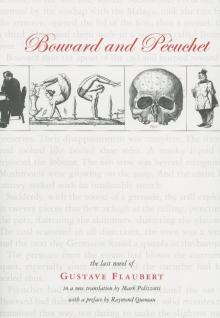 Bouvard and Pecuchet
Bouvard and Pecuchet Madame Bovary
Madame Bovary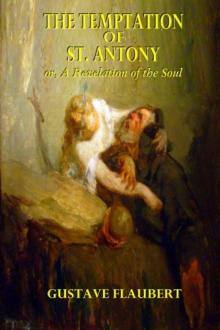 The Temptation of St. Antony
The Temptation of St. Antony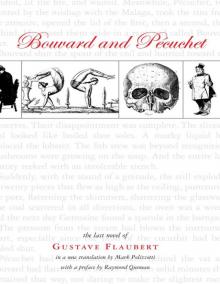 Bouvard and Pécuchet: A Tragi-comic Novel of Bourgeois Life, part 1
Bouvard and Pécuchet: A Tragi-comic Novel of Bourgeois Life, part 1 Three Tales
Three Tales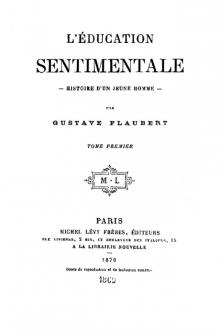 Education sentimentale. English
Education sentimentale. English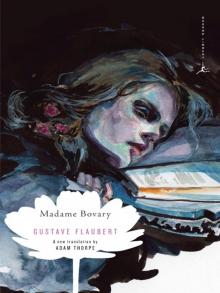 Madame Bovary (Modern Library)
Madame Bovary (Modern Library)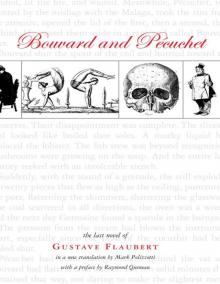 Bouvard and Pécuchet: A Tragi-comic Novel of Bourgeois Life, part 2
Bouvard and Pécuchet: A Tragi-comic Novel of Bourgeois Life, part 2 Sentimental Education; Or, The History of a Young Man. Volume 1
Sentimental Education; Or, The History of a Young Man. Volume 1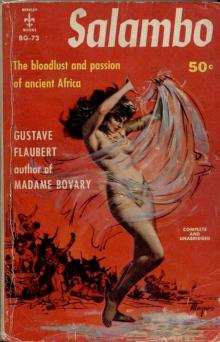 Salammbo
Salammbo Memoirs of a Madman and November
Memoirs of a Madman and November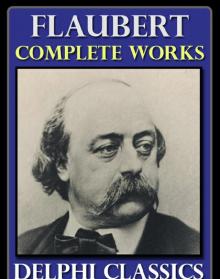 Complete Works of Gustave Flaubert
Complete Works of Gustave Flaubert